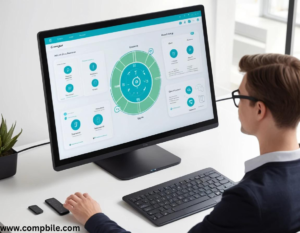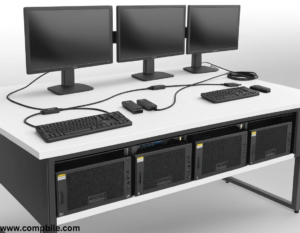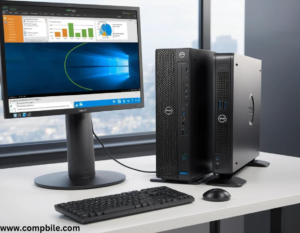- OptiPlex 3000 Thin Client The OptiPlex 3000 is generally compact and space-efficient, designed to save physical space while offering easy mounting options.
- It may have a fan less design, making it quieter and more durable for continuous operation.

2. Hardware:
- Processor: The thin client typically uses energy-efficient processors like the Intel Celeron, Pentium, or Core i-series, depending on the configuration.
- Memory: It usually comes with 4GB or more of RAM (expandable), which supports most thin-client workloads.
- Storage: These devices generally use flash storage (e.g., SSD) with lower capacity than regular desktops, as they rely on external servers for most of the data processing.
3. Operating System:
- The OptiPlex 3000 Thin Client typically runs lightweight operating systems like Windows 10 IoT Enterprise, Thin OS, or Linux-based systems, optimized for remote desktop services, Citrix, VMware, or Microsoft RDP (Remote Desktop Protocol).
4. Connectivity:
- USB Ports: Multiple USB ports for peripherals like keyboard, mouse, and other devices.
- Networking: Ethernet ports and possibly Wi-Fi options for seamless internet and server connectivity.
- Display: Support for multiple monitors, often through HDMI or DisplayPort, to support extended desktop or multiple workstation setups.
5. Use Cases:
- The OptiPlex 3000 Thin Client is perfect for businesses or industries that rely on cloud computing, virtual desktop infrastructure (VDI), or centralized computing.
- It’s commonly used in environments such as:
- Call centers
- Healthcare
- Retail operations
- Education
6. Management and Security:
- The device comes with management tools that allow IT administrators to control and configure settings across multiple devices from a central location.
- Security features include encryption, multi-factor authentication, and access control to ensure sensitive data is protected.

7. Energy Efficiency:
- Thin clients are known for their low energy consumption since they don’t handle heavy workloads locally. This makes the OptiPlex 3000 Thin Client an environmentally friendly choice for companies looking to reduce their carbon footprint.
Detailed Specifications of the OptiPlex 3000 Thin Client
1. Processor CPU
- Intel Celeron or Intel Pentium processors are common in thin clients due to their efficiency and lower power consumption. Some configurations may offer Intel Core i3 processors.
- These processors are ideal for handling basic to moderately demanding remote computing tasks and virtual desktop infrastructure (VDI).
- The CPU supports multiple threads and virtual machines, but it is less powerful compared to traditional desktop CPUs since its main purpose is to handle simple user interfaces and connect to cloud or server resources.

2. Memory RAM
- Typically, the OptiPlex 3000 Thin Client comes with 4GB to 8GB of RAM, which is sufficient for basic computing tasks in a thin-client environment.
- RAM is important for handling multiple sessions and virtual machines when running applications like remote desktops or virtualized apps.
3. Storage
- Solid-State Drive (SSD): Thin clients typically use eMMC storage or SSD for fast boot times and reliability.
- Storage capacities usually range from 16GB to 64GB, with most of the data storage and application processing happening remotely. This minimizes the need for local storage.
- The smaller local storage capacity is also a security feature, as it reduces the potential for data breaches from compromised local devices.
4. Operating System
- Thin OS or Windows 10 IoT Enterprise: These operating systems are designed for remote desktop and virtualization use cases. Thin OS is lightweight, secure, and optimized for connecting to virtual environments like VMware Horizon, Citrix, or Microsoft RDP.
- Linux-based OS options are also common in certain configurations, particularly when using open-source virtualization platforms or other remote access technologies.
5. Connectivity
- Ethernet Ports: Typically supports Gigabit Ethernet for fast wired network connectivity, essential for stable remote desktop or cloud application access.
- Wi-Fi: Some models may offer Wi-Fi connectivity (often Wi-Fi 5 or Wi-Fi 6) for flexible wireless access in business environments.
- Bluetooth: For connecting wireless peripherals like keyboards, mice, and headsets.
6. Video and Display
- HDMI/DisplayPort: Supports HDMI or DisplayPort outputs, allowing dual or multi-monitor setups, which are common in business settings.
- Resolution: The thin client can handle standard HD (1080p) resolutions, and in some models, higher resolutions (up to 4K) for professional use.

7. Ports and Expansion
- USB Ports: Typically includes 4 to 6 USB ports (USB 2.0 and USB 3.0), which can be used for keyboards, mice, printers, scanners, USB drives, and other peripherals.
- Audio Ports: In and out ports for speakers, microphones, or headsets.
- Serial Port (optional): For legacy devices that require serial communication, particularly useful in industries like healthcare or retail.
8. Power Supply
- Low Power Consumption: Thin clients are known for their energy efficiency. The OptiPlex 3000 Thin Client consumes much less power than traditional desktop PCs since it offloads the majority of processing to centralized servers.
- The device can operate with a 12V DC power supply, often with a small power brick for easy deployment in various environments.
9. Security Features
- Endpoint Security: Thin clients typically have built-in security features such as TPM (Trusted Platform Module), secure boot, and encryption.
- Multi-factor authentication (MFA) support, which can be crucial for ensuring secure access to remote virtual desktops.
- Remote Management: The OptiPlex 3000 Thin Client can be managed and updated remotely, reducing IT overhead and enhancing security posture.
10. Physical Dimensions
- Typically compact, with dimensions around 1.5”–2” in height, 6”–7” in width, and 6”–7” in depth. This makes it highly space-efficient for businesses that need to deploy multiple units in tight spaces like call centers, clinics, or retail setups.
- Some models can be mounted behind a monitor or on the wall, further reducing desk clutter.
Use Cases and Industry Applications
1. Virtual Desktop Infrastructure (VDI)
- OptiPlex 3000 Thin Clients excel in environments that use VDI solutions, like VMware Horizon or Citrix Xen Desktop. These devices connect to virtual desktops running on powerful servers, allowing workers to access personalized desktop environments remotely. This is perfect for industries like:
- Healthcare: Doctors and nurses can securely access patient data remotely through a centralized server.
- Education: Schools and universities can deliver standardized computing environments to students with minimal IT management.

2. Remote Work and Cloud Computing
- The OptiPlex 3000 is also suited for businesses that rely heavily on cloud services like Microsoft 365, Google Workspace, or custom cloud applications. Employees can access these services remotely while using minimal local resources.
- Ideal for remote workers who require a secure, lightweight device to access cloud-based applications or workstations from anywhere.
3. Call Centers and Customer Support
- In call centers, the OptiPlex 3000 Thin Client is ideal because of its compact size, durability, and ability to handle multiple sessions (e.g., accessing CRM software, customer databases, etc.).
- Thin clients are also less prone to failure, offering high uptime in demanding environments.
4. Retail and POS Point of Sale Systems
- Retail businesses often use thin clients for POS systems. The OptiPlex 3000 Thin Client provides a reliable and secure platform for processing transactions while integrating with back-end servers.
- The compact form factor allows easy integration into point-of-sale terminals without taking up much space.
5. Manufacturing and Industrial Environments
- Thin clients are used in industrial settings for monitoring production lines, managing inventories, and controlling automation systems. Their low power usage, reliability, and compact design make them well-suited for rugged environments.
Get artical on pdf file… click now
…………. OptiPlex 3000 Thin Client ………….

